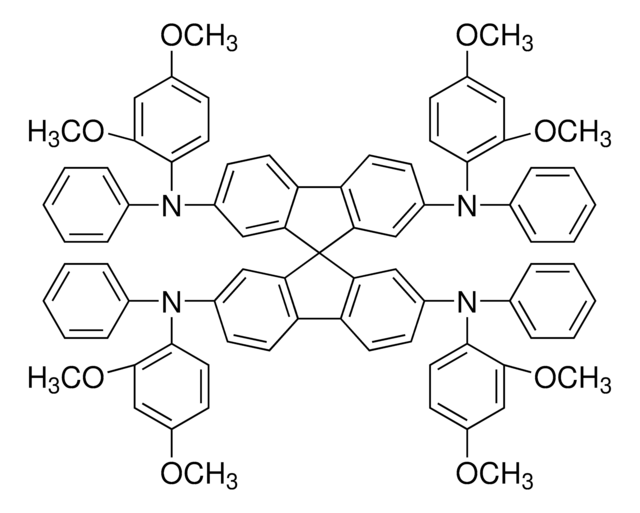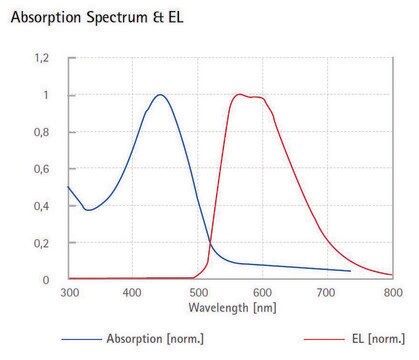902500
SHT-263 Solarpur®
Sinônimo(s):
N2,N2,N2′,N2′,N7,N7,N7′,N7′-octakis(4-methoxyphenyl)-9,9′-spirobi[9H-fluorene]-2,2′,7,7′-tetramine, Spiro-MeOTAD, Spiro-OMeTAD
About This Item
Produtos recomendados
Ensaio
≥99.9%
Nível de qualidade
forma
powder
características do produto alternativo mais ecológico
Design for Energy Efficiency
Learn more about the Principles of Green Chemistry.
sustainability
Greener Alternative Product
Impurezas
≤0.1% Residual solvent
pf
247 °C
categoria alternativa mais ecológica
InChI
1S/C81H68N4O8/c1-86-65-29-9-53(10-30-65)82(54-11-31-66(87-2)32-12-54)61-25-45-73-74-46-26-62(83(55-13-33-67(88-3)34-14-55)56-15-35-68(89-4)36-16-56)50-78(74)81(77(73)49-61)79-51-63(84(57-17-37-69(90-5)38-18-57)58-19-39-70(91-6)40-20-58)27-47-75(79)76-48-28-64(52-80(76)81)85(59-21-41-71(92-7)42-22-59)60-23-43-72(93-8)44-24-60/h9-52H,1-8H3
chave InChI
XDXWNHPWWKGTKO-UHFFFAOYSA-N
Descrição geral
Aplicação
Informações legais
Código de classe de armazenamento
11 - Combustible Solids
Classe de risco de água (WGK)
WGK 3
Ponto de fulgor (°F)
Not applicable
Ponto de fulgor (°C)
Not applicable
Escolha uma das versões mais recentes:
Certificados de análise (COA)
Não está vendo a versão correta?
Se precisar de uma versão específica, você pode procurar um certificado específico pelo número do lote ou da remessa.
Já possui este produto?
Encontre a documentação dos produtos que você adquiriu recentemente na biblioteca de documentos.
Os clientes também visualizaram
Artigos
Professor Chen (Nankai University, China) and his team explain the strategies behind their recent record-breaking organic solar cells, reaching a power conversion efficiency of 17.3%.
Conteúdo relacionado
Organic electronics utilizes organic conductors and semiconductors for applications in organic photovoltaics, organic light-emitting diodes, and organic field-effect transistors.
Nossa equipe de cientistas tem experiência em todas as áreas de pesquisa, incluindo Life Sciences, ciência de materiais, síntese química, cromatografia, química analítica e muitas outras.
Entre em contato com a assistência técnica


![[6,6]-Phenyl C61 butyric acid methyl ester ≥99%](/deepweb/assets/sigmaaldrich/product/structures/359/221/d990c746-0960-4c69-bf76-fe09b193824d/640/d990c746-0960-4c69-bf76-fe09b193824d.png)








